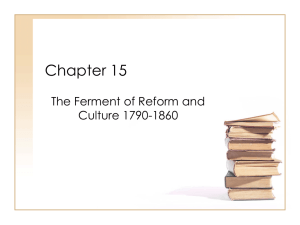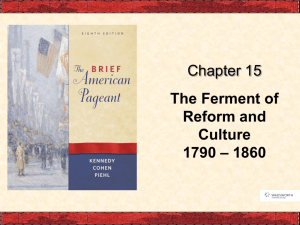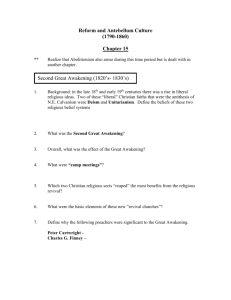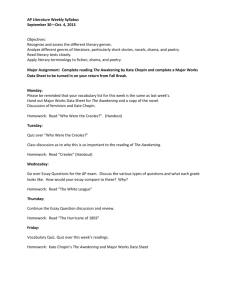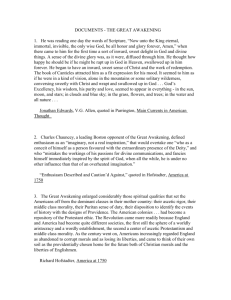2 nd Great Awakening
advertisement
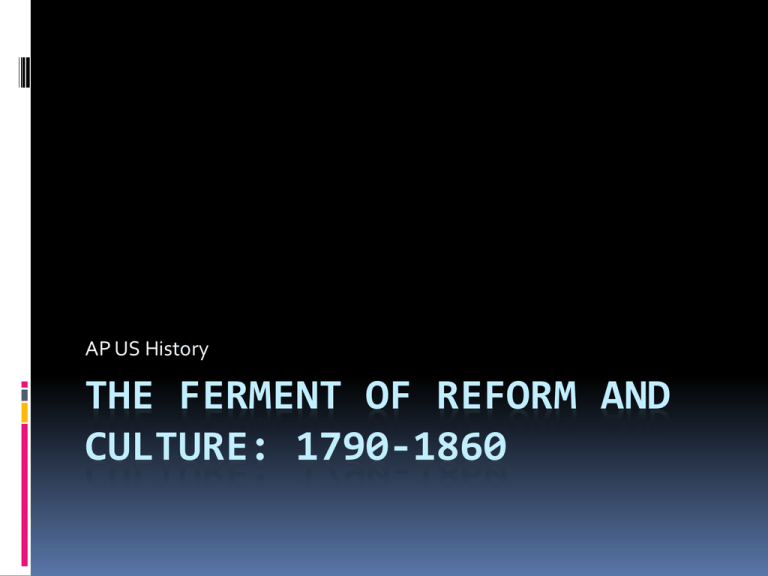
AP US History THE FERMENT OF REFORM AND CULTURE: 1790-1860 Introduction We have seen two revolutions involving the shaping of America up to this time now we have a third. Revolution 1: Political (Rise of Mass Democracy) 2. Revolution 2: Economic (Self-Sufficient System) 3. Revolution 3: Cultural (Religion, social) 1. Reviving Religion 1850: ¾ of the population still attends church Over time the zeal of the old-time (Calvinism) had been fading Thomas Paine “Age of Reason” Churches are “set up to terrify and enslave mankind and monopolize power and profit” Reviving Religion Deism- Believed in a supreme being who created mankind with a capacity for moral behavior CLOCKMAKER THEORY This was the belief of many founding fathers Jefferson (Jefferson Bible) Franklin Reviving Religion Unitarianism- Believe in a God (1 Person not Trinity) and that human nature is good. Salvation through good works Essentially believe what ever you want RELIGION IS BECOMING MORE LIBERIAL AS IT STRAYS FROM ITS FOUNDATION! Reviving Religion Reaction to Liberalism = 2nd Great Awakening 2nd Great Awakening- A wave of religious revivals which spread to the masses with “camp meetings” Lager then 1st Great Awakening One of the most monumental episodes in American Religion! Reviving Religion Results of 2nd Great Awakening Spurred on missionary work (Hawaii, Indians, Foreign) Created splits in denominations EX: Southern Baptists and Baptists How do we see sectionalism through this? Reviving Religion Charles Finney Greatest revival preacher Kept Audiences captive with his mix of old-time religion and innovative thoughts. Denounced alcohol/slavery President of Oberlin College (hotbed for abolitionist movement) Reviving Religion Women in 2nd Great Awakening KEY of the 2nd Great Awakening=feminization of religion (membership/theology) Middle class women = strongest supporters and largest population IMPORTANCE: SPREAD RELIGION FROM HOME OUTWARD Denominational Diversity Revivals fragmented religious faiths EX: Burned-Over District, NY Sectionalism EAST: wealthier, more conservative, well educated tended to not be effected as much. South/West: poorer, less learned, rural, they were more affected by revival waves. WHY? They need something to bolster their spirits. Slavery is a huge issue Review What are the three different revolutions we see come about in the United States from 1790-1860? How did we see the rise in sectionalism displayed through the 2nd Great Awakening? A Desert Zion Mormons- members of the Church of Jesus Christ of Latter Day Saints. Founded by Joseph Smith (NY) After his murder the mission is picked up by Brigham Young as they moved west to Utah. Great example of Westward expansion. Free Schools for a Free People Tax supported schools are scarce early on in United States early on. REASON: They are associated w/ poor b/c that is who they were for. “ragged schools” Wealthy eventually saw the light. REASON: if they did not educate the ignorant they would eventually be dangerous and have the vote. This is their insurance for a stable democracy Free Schools for a Free People Public education triumphed between 1825-1850 Lagged behind in the South (rural, spread out) Early free schools were very bad One room school house 2. Open only a few months a year 3. Teachers ill trained, under paid, bad tempers (men) 4. Taught the Three R’s 1. 1. Readin, ritin and rithmatic Free Schools for a Free People School Reform Horace Mann (1796-1859) “Father of public education” Proposed More/Better Schools Longer Terms Better pay for teachers Expanded Curriculum Noah Webster: Webster’s Dictionary, Reading books William H. McGuffy: McGuffy’s Reader Higher Goals for Higher Education The main goal of higher education at this time is religious training (Ivy League) Spurred on by zeal from 2nd Great Awakening State Supported Schools First in the South (Univ. of Virginia 1819) Women schooling still rare Age of Reform 2nd Great Awakening led to many social reforms (3 Main) Temperance Movement (Anti-Drinking) Women’s Rights Movement Abolitionists Movement (Anti-Slavery) Women are prominent in reform movements. REASON: Allows them to escape the confines of the home and have voice heard. Age of Reform Demon Rum-The “Old Deluder” Reasons for increased drinking: Customs of the day Hard/monotonous labor (factories/agriculture) PROBLEMS CAUSED BY ALCOHOL Decreased efficiency of labor Danger of accidents at work Fouled the sanctity of marriage Threatened spirituality/safety in home Demon Rum-The “Old Deluder” American Temperance Society (Boston 1826) Group of reformers against the use/manufacturing of alcohol. Thy used print, pictures and lectures very effectively. T.S.Arthur: wrote Ten Nights in Barroom and What I Saw There (1854). Told of how entire town ruined by a tavern What did taverns mean at time of Revolution? 2nd highest selling book at the time. Demon Rum-The “Old Deluder” Two Major Lines of Attack To stiffen the will of the people to resist drinking 2. To remove alcohol altogether by legislation 1. Neal S. Dow (Maine): “The Father of Prohibition” Maine Law of 1851- prohibited the manufacturing and sale of liquor in the state. REVIEW WHAT ARE THE THREE REVOLUTIONS THAT TOOK PLACE IN THE US FROM 1790-1860? WHAT ARE THE THREE MAIN REFORMS THAT THE 2ND GREAT AWAKENING HELPED AID? Women in Revolt Role of women at beginning of 19th century = subordinate housewives They couldn’t vote Couldn’t inherit land They could be legally beaten by their husbands This sounds a lot like the life of blacks at the same time. Women in Revolt Even with all the negatives they still faired better then European women. Marriage is a choice (unlike colonial times) 10% were spinsters at the time of the Civil war Women were thought to be keepers of “societies conscience” Home belonged to the women They are responsible for raising good and productive citizens of the Republic Women in Revolt Women’s Rights Movement Seneca Falls Convention (1848) Led by Elizabeth Cady Stanton and Lucretia Mott. Declaration of Sentiments “ all men and women are created equal” WHAT RIGHTS THEY WANTED Women’s suffrage Women’s right to retain property after marriage Greater divorce and child custody rights Equal education opportunities Women in Revolt Leaders of Women’s Rights Lucretia Mott Susan B. Anthony Elizabeth Cady Stanton Importance: Launched the modern day women’s rights movement. Wilderness Utopia There was a small group of reformers who sought a communitarian lifestyle Utopia- A perfect society Robert Owen- 1825 founded New Harmony Brook Farm- Massachusetts in 1841 Oneida Community- NY 1848, most radical attempt. “Free Love” Shakers- longest est. sect of communitarians. Didn’t believe in marriage or procreation, died out by 1940’s. The Dawn of Scientific Achievement Early American’s are more concerned w/ practical gadgets then pure science. REASON: Inventions solved their problems THERE IS SCIENCE BUT VERY LITTLE! The Dawn of Scientific Achievement Professor Benjamin Silliman (1799-1864) Chemist/Geologist Taught and wrote at Yale for 50 years. The Dawn of Scientific Achievement John J. Audubon (1785-1851) Studied birds in America “Birds of America” The Dawn of Scientific Achievement Advances in Medicine? Medicine is still in its infancy Bleeding was still the preferred method of healing Disease is still a huge problem Epidemic in Philadelphia in 1793. “Bring out your dead” Lifespan = 40 years for whites, less for blacks in 1850 Surgery is very brutal Artistic Achievement Painting Painting is still handicapped REASON: Not enough people w/ money to pay/sit for paintings in US. Some good artists still emerge Gilbert Staurt Charles Willson Peale John Trumball Artistic Achievement Hudson River School A group of artists led by Thomas Cole, who painted landscapes emphasizing America’s national beauty (uniqueness) America’s first coherent school of art! Blossoming of National Literature What type of writing have we seen thus far? Political (most successful early writing) American literature receives a boost from nationalism post-Revolution/1812 Why do you think this is? Blossoming of National Literature Knickerbocker Group (3 New Yorkers) 1. Washington Erving (1783-1859) 1st to earn international recognition He interpreted America to Europe The Legend of Sleepy Hollow Rip Van Winkle Blossoming of National Literature James Fenimore Cooper (1789-1851) 1st American Novelist The Last of the Mohicans Blossoming of National Literature William Cullen Bryant (1794-1878) American Poet THE KNICKERBOCKERS GAVE AMERICA ITS OWN STYLE IN MULTIPLE GENRES OF WRITING. Trumpeters of Transcendentalism Transcendentalism A philosophy and literary movement of the 1800’s that emphasized living a simple life while celebrating the truth found in nature and in personal emotion and imagination. Golden Age of American Literature = 2nd quarter of 19th century. Trumpeters of Transcendentalism Ralph Waldo Emerson (1803-1882) He urged writers to do away w/ European tradition and search the riches of America for inspiration. “I hate quotations. Tell me what you know.” Trumpeters of Transcendentalism Henry David Thoreau (1817-1863) He was thrown in prison for not paying his Massachusetts poll tax. Civil Disobedience (1849) Walt Whitman (1819-1892) Leaves of Grass (1855) Growing Literary Lights Female Literary achievements Louisa May Alcott (1832-188) Little Women (1868) Emily Dickenson (1830-1886) Extraordinary talent in poetry Over 2,000 poems published after her death. Growing Literary Lights Other contributors Nathaniel Hawthorne (1804-1864) The Scarlet Letter Herman Melville (1819-1891) Moby Dick, Billy Budd Edgar Allan Poe (1809-1849) The Raven, The Cask of Amontillado Growing Literary Lights Literature from the south The South did not contribute much to early literary movements. WHY? Poor schooling Illiterate Portrayers of the Past Many notable historians came from this era George Bancroft (1800-1891) “Father of American History” Wrote a 6 volume history in 1789 Others of note William H. Prescott Francis Parkman There is a heavy NE bias to early histories.


